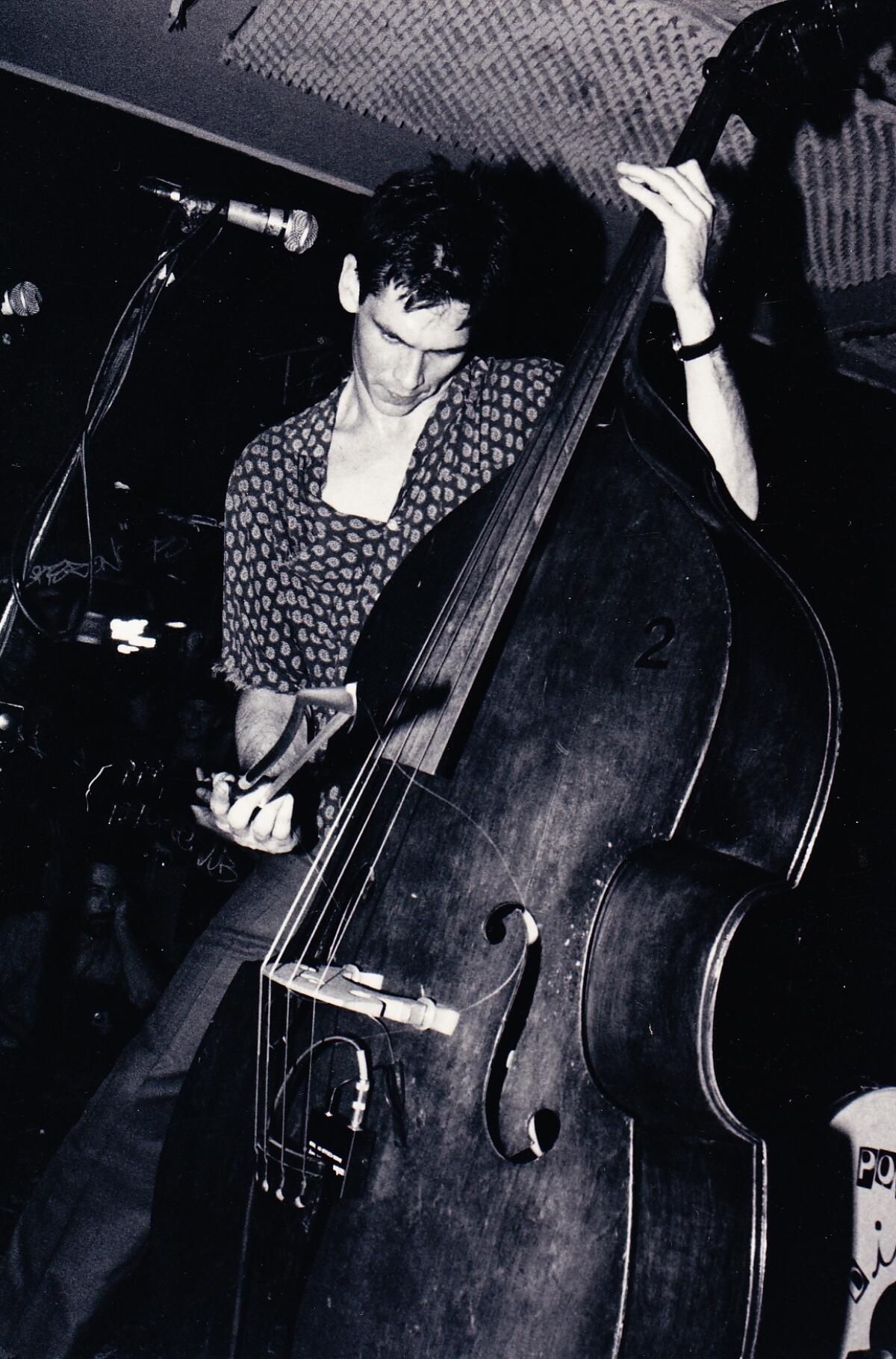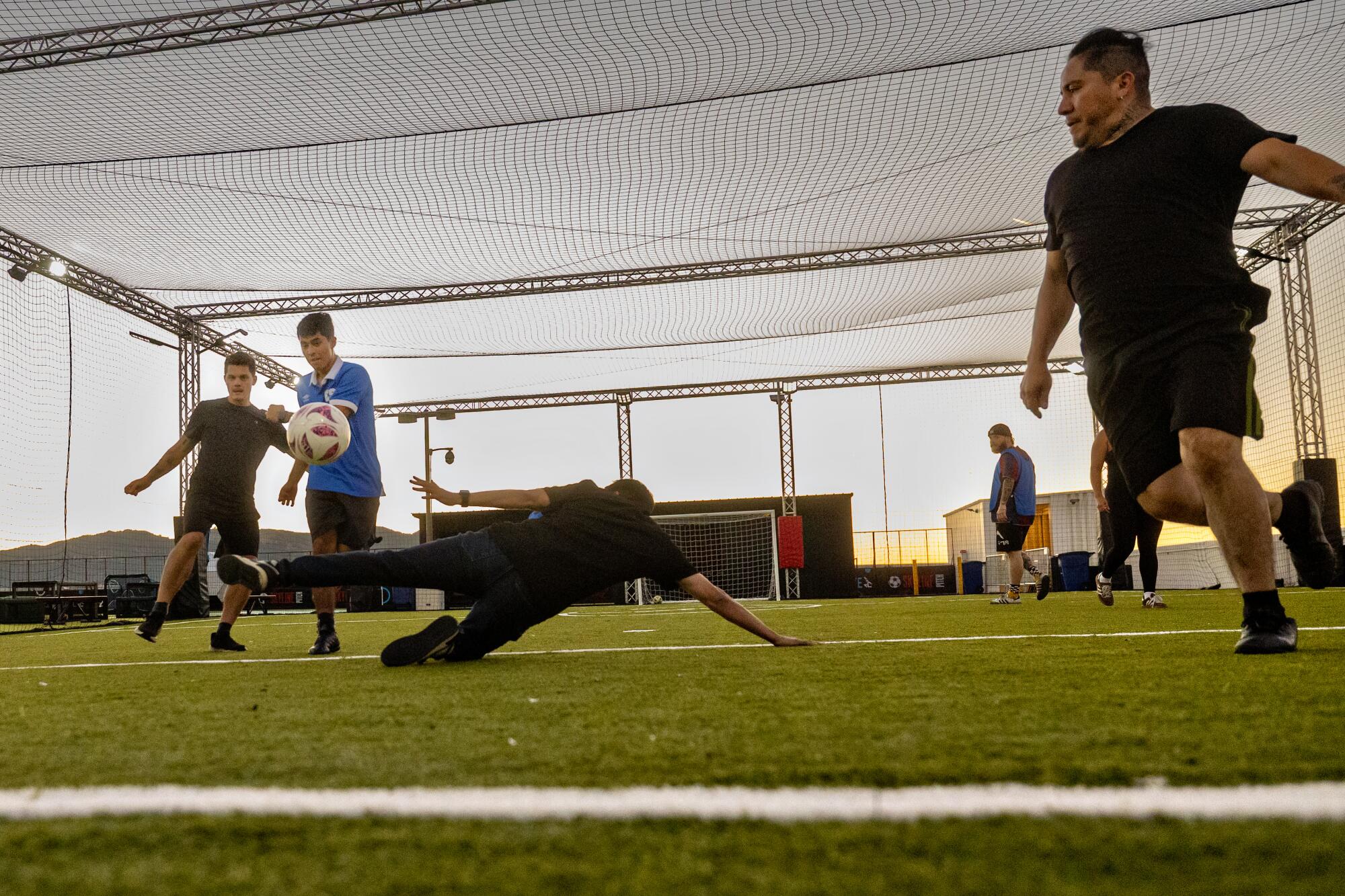Spaceland orbits back to Silver Lake’s musical heyday
Silver Lake earned the “hipster” handle long before Spaceland opened its doors. But when the club threw its first show in March 1995 at the venue formerly known as Dreams of L.A., it marked a notable energy shift that made everyone take notice, establishing the neighborhood as a trendsetter and hub for creative talent. The live music space was the right idea, in the right place, at the right time.
Atmospheric dive bars, funky/punky mom-and-pop shops and reasonable rents began attracting artists, musicians and bohemian slackers and scenesters as residents in the early ’90s. They joined its vibrant queer community and multigenerational familial (mostly Latino) populace, which combined to make it one of the coolest places to live in L.A. It still is, albeit pricier and more pretentious, if you ask those who grew up there.
But 30 years ago things were different — the area was hip, but it also felt effortlessly eccentric. The annual Sunset Junction Street Fair, which closed off Sunset Boulevard between Fountain and Edgecliffe Drive beginning in the ’80s, started booking more legacy bands and hot new groups, broadening the cultural consciousness of the city and bringing Angelenos from all over town to the area until it ceased in 2010.
Silver Lake’s music mecca status was ultimately cemented when promoter Mitchell Frank decided to turn his weekly live music night at Dreams called Pan into a bona fide rock venue, taking what was bubbling in the streets, at house parties in the hills and at nearby rehearsal spaces and providing a singular home for music makers to nurture and grow their followings.
Opening night marked a benefit for quirky noise rockers Lutefisk, who lived in the area and, like many there, rehearsed at Hully Gully on Fletcher Drive. After their equipment was stolen, they put together a bill of buzzy local artists to raise funds, including headliner Beck, who got his start at the artsy coffeehouse called the Onyx next to the Vista Theatre, and later on Vermont Avenue in Los Feliz Village.

Rob Zabreckyn of Possom Dixon
(Arlen Hem)
Coupled with the darkly melodic alt-rock of Possum Dixon as openers, the show was a hot ticket. As last-minute luck would have it, the night became even more monumental with an early show addition — the debut of Dave Grohl’s new project called the Foo Fighters.
“It was just crazy. That night it was raining and both shows sold out,” recalls Lutefisk drummer Brandon Jay. “It was that lovely moment in time when KBLT started broadcasting and there was a growing scene in Silver Lake when everyone was like, ‘Oh, Silver Lake is the new Seattle’ — only it was more diverse.”
Jay, who went on to play with other bands like the 88 and Gwendolyn and the Good Time Gang, hopes to remind local music fans about the seminal scene at the Regent this Saturday, where Lutefisk reunites alongside Dixon’s Rob Zabrecky (playing with various luminaries from the club) and Spaceland favorites Touchcandy, the Centimeters, Jon Wahl (Claw Hammer), Sissy Bar, W.A.C.O. and more.
“This show is as close as you’re gonna get to a real ’90s Spaceland night,” assures Frank. “Touchcandy, Lutefisk, Centimeters, Rob from Possum Dixon and Sissy Bar … this is the exact kind of beautiful symphonic chaos that defined that ’90s era. Nights like this are what propelled a fractured Eastside music scene into becoming a full-fledged scene.”
Indeed, gathering disparate genres, styles and niches in one place was what made this scene unique. “There were so many wonderful, eclectic bands,” Jay adds. “A bunch got signed, but you know, fame is a fickle thing, and you never know what might get played on the radio.”
Plenty who played at the club did. In addition to Beck and the Foos, local acts who broke after playing there include Silversun Pickups (named after a nearby liquor store), Rilo Kiley and the Airborne Toxic Event, while touring indie artists also earned their stripes in front of the mylar curtain-backdropped stage, namely the White Stripes, Arcade Fire, Arctic Monkeys, Jet, Ween, Cold War Kids, Death Cab for Cutie, Amy Winehouse … and the list goes on and on.
“There was a point in time where bands were coming through town on tour and playing L.A. for the first time and their agents all wanted them to play Spaceland’s Monday residency,” remembers former head booker Jennifer Tefft of the no-cover event, which became legendary by the early 2000s. “They played for free, but it allowed them to be seen. Everyone wanted to play there and not just on a local level, but on an international level. NME in the U.K. were giving the club so much press, so all these bands wanted to come to L.A. for it … Bloc Party, the Killers and My Morning Jacket all made their debuts at the club.”
Tefft went on to book the Bootleg Theater, but later returned to work with the building’s owner, Jeff Wolfram, to breathe new life into the Silver Lake space under the name the Satellite. It closed due to pandemic struggles in March 2020 and remains shuttered. Meanwhile, Frank, along with booker Liz Garo, left the venue — which was technically still called Dreams, to focus on his new space, the Echo and its later addition, the Echoplex.
He sold the Echo Park complex, along with the Regent, to Live Nation in 2019, but still remains involved in booking and other club business dealings. All three figures deserve credit for the cosmic alchemy and community spirit that made Spaceland and the world it created so game-changing. They really cared about the people who played there and would often champion their favorites and help build their followings through promotion and advertising, namely in the free print edition of LA Weekly.
“We all had the same sort of passion and curiosity about music and supporting locals,” shares Garo, who booked at Spaceland when Tefft left, and really made her name at the Echo. “I think that’s why it kept that integrity.”
There is no shortage of fond, slightly fuzzy memories at Spaceland. There were also many games of pool in their infamous upper-level smoking room (which puffed on even after the ’98 bar smoking ban due to a loophole).
Free Monday promotions were nothing new — Club Lingerie in Hollywood had been doing them for years — but Spaceland’s were magical for both the bands and the fans because of the monthlong residency model. Besides being budget-friendly and clearly well-curated, boasting up-and-comers and offering big-name surprises, it was a place to meet like-minded alternative types who fancied the same fashions, art and pop culture references.
Most of the local musicians who played there seemed to know each other simply from hanging out so much and those who proved themselves on stage were rewarded with new followings that got bigger each week.

The Centimeters perform at Spaceland
(Wild Don Lewis)
“Jen had a really good formula — you would do your residency, then you would not do another show for six weeks or so, and then you’d come back and do a ticketed show,” Garo explains. “Ideally that worked and kind of helped establish that bands could sell tickets. You know, when bands start off, they’re playing to their friends in the audience. When they get to that point where they don’t know anybody in the audience, that’s kind of a big deal.”
Beyond exposure and local notoriety, for Zabrecky, Jay and countless musicians who had residencies — many of whom will be seeing each other for the first time in years at the Regent show — Spaceland was formative not only for their music but also for their life trajectories.
“Playing Spaceland with Possum Dixon was always unpredictable,” recalls Zabrecky, who went on to become a revered magician and performer. “We never knew which direction a show might go. Every band was different, yet everyone was accepted and celebrated for what they were. Groups like Glue, Spindle, W.A.C.O. and the Abe Lincoln Story couldn’t have been more different from each other, and that made every lineup exciting. And, of course, we were all just making it up as we went along, buoyed by the support of our peers.”
The transitional period between Spaceland and the Satellite is marked by the band who helped put it on the map and unintentionally kicked off the fervor to begin with. The Foo Fighters chose the locale for their series of surprise pop-up shows debuting new material in 2011, right before the venue was renamed.
The next year, Forbes dubbed Silver Lake “America’s Hippest Hipster Neighborhood,” which meant it was no longer … that. American Apparel stores had infiltrated, corporate coffee was everywhere and artists were getting priced out, heading East into Echo Park, Mt. Washington, Highland Park and downtown too, with many of the bars and clubs in those regions seeking to capture the old Spaceland vibes. They still do.

Brian Wilson onstage with the Wondermints at Spaceland
(Courtesy of Brandon Jay)
In this way, Spaceland’s legacy has lasted beyond Gen X nostalgia for the good old days. Inspired by the fervent framework for music discovery and social connection of the past, new bands now showcase their stuff at the Echo, Regent, Zebulon, Redwood Bar and many more, eschewing Hollywood and the Sunset Strip for more laid-back environments.
Frank continues to lend his expertise to Live Nation; Garo is planning events and working with venues, from acoustic sets at her book shop Stories in Echo Park to her just-announced gig booking for Grand Performances downtown; and Jay, who lost his home in the California wildfires, turned the tragedy into a beautiful music exchange program called Altadena Musicians. He’s also involved in a new all-ages music venue called the Backyard Party in Pasadena, noting that a new generation of art-minded music rebels continues to thrive just like they did at Spaceland three decades ago.
Jay is also helping with the Regent show planning, and put in the call to Touchcandy’s David Willis, who’ll be flying into town from the U.K. just for the show. Word has also been put out to Beck and Grohl (though no commitments have been made), and the pirate radio station KBLT, whose documentary “40 Watts from Nowhere” counts Jay and Jack Black as producers, will offer sets from its deejays in between the live sounds.
The lineup listed on the event flier is meant to evoke the original benefit promo from ’95, and it represents the magnificent music mix all on its own, flashing back to an exciting era that L.A. music lovers who experienced it will never forget, a time when the scene was “young and free,” as Zabrecky remembers, and those lucky enough to be on the marquee played what he dubs “the best club at the best moment on Earth.”
“These bands were messy, loud, indie, real and somehow still innovative,” Frank adds of the 30th anniversary show, which is being touted as a Vol. 1, suggesting more to come. “Shows like this are the reason any of it mattered.”





